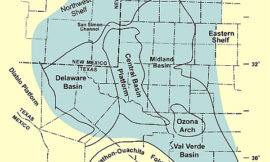In this episode, we discuss the recently proposed Texas Pore Space Bills which seek to address ownership and pooling of pore space for CO2 sequestration. We unpack what this legislation would do and how it could negatively affect mineral owners.
Be sure to also subscribe on Apple Podcasts via the link above and please leave us an honest rating and review. We read every one of them and sincerely appreciate any feedback you have. To ask us a question to be featured on an upcoming episode, please leave a comment below or send an email to feedback@mineralrightspodcast.com.
Background
As a refresher, at the Federal level, the US Environmental Protection Agency (EPA) regulates the underground injection of fluids for storage or disposal is covered under the Underground Injection Control (UIC) program. We cover this in more detail in MRP 151: Types of Underground Injection Wells
In 2021, the Texas legislature passed House Bill 1284 which specified that the Texas Railroad Commission would administer the Class VI UIC program which covers CO2 sequestration facilities. This bill set the framework to allow streamlining the permitting process for CO2 sequestration in Texas but there was a gap around defining underground pore space ownership and for managing liability for carbon sequestration projects, and for how to handle these projects when approval of all pore space owners cannot be obtained. In other words, there needs to be statutory pooling provisions for the pore space.
Who Owns the Pore Space?
Defining the ownership of the pore space is important because it will dictate who needs to be compensated for storing CO2 underground. We covered this in more depth in: MRP 99: Carbon Capture and Enhanced Oil Recovery.
To recap a couple of important concepts and how CO2 sequestration in Texas could impact mineral owners there, it is important to discuss who owns the pore space in the rock underground. The pore space is the empty space within the rock. In fact, water and oil and gas or any substance doesn’t usually exist in large underground lakes or rivers, instead the oil and gas or water exists in the empty spaces between the grains of the rock. The amount of empty space within a material is called the porosity. So what we are talking about is who owns that empty space (not the oil or gas that might be there, which belongs to the mineral estate).
Surprisingly, most of the legal cases involving the right to inject and store natural gas underground and this question of who owns the pore space have sided with the surface estate. The reasoning behind this is “because the pore space represents the absence of minerals, and the surface owner therefore owns the geologic storage rights.” This conclusion is sometimes referred to as the “American rule” because English courts actually came to the opposite conclusion. While many states have adopted the American rule, Texas law is not as clear.
Texas Pore Space Bills
Which brings us to the recently proposed SB 2107 and HB 4484 which were proposed recently in the Texas House and Senate Committees on Natural Resources & Economic Development.
The Texas Pore Space Bills are currently being proposed in the Texas House and Senate committees on natural resources economic development as a way to establish a legal framework for CO2 capture and sequestration projects in Texas. The bills aim to define how geologic storage facilities fit into current laws and establish new laws where there is ambiguity. They also address how associated injection wells should be handled and outline the rights and process for pooling the pore space to develop a geologic storage facility.
The bills are being proposed simultaneously in both the House and Senate, indicating the importance of this issue. Mineral and royalty owners are concerned about how the bills might affect their property rights, particularly with respect to compensation for any loss of value resulting from CO2 sequestration. The bills currently define ownership of CO2 stored in a geologic storage facility as property of the storage operator, unless it is transferred to the state.
How it Could Affect Mineral Owners
At the end of the day, there are some concerns that remaining ambiguity in the proposed legislation could hurt mineral owners. For example, there is not clear statement that protects existing wells or the ability to drill under the Geologic Storage Facility horizontally, even if you take precautions to case and prevent escape of any stored CO2. Additionally, if a proposed Geologic Storage Facility could impair the mineral rights in the area, it would be reasonable to provide a process for mineral owners to object or provide comment to the state to ensure that the Geologic Storage Facility is developed in a way that still enables mineral development in the area.
From a surface owner perspective, the “integration” (essentially pooling) process still has some gaps as well. Specifically, there is also concern about the process of gaining approval of 60% of the affected surface owners required to create a storage facility and there are no time requirements for a “fair and reasonable offer” to be made to these owners.
The Texas Chapter of the National Association of Royalty Owners (NARO) prepared some talking points on the concerns affecting mineral owners. The talking points, contact information for state representatives, and any updates on the legislation can be found here. If you own mineral rights in Texas, contact these state representatives to let them know your concerns.
The bills should establish a process for compensating mineral owners if the CO2 sequestration limits future mineral development. Mineral owners are concerned that they will not be included in the process or notified about potential storage facilities. The bills need to address these concerns to ensure that mineral and royalty owners are fairly compensated and their property rights are protected.
The bills also define how ownership of the pore space and CO2 in a geologic storage facility is transferred to the state if the facility is decommissioned. The state will manage these interests, and the bills define the process for transferring ownership. Mineral owners should be included in the process to ensure that their property rights are protected.
Resources
- Mineral Owner Talking Points and Call to Action
- MRP 99: Carbon Capture and Enhanced Oil Recovery
- MRP 151: Types of Underground Injection Wells
- Who Owns Pore Space for Geologic Carbon Sequestration? Renewed Focus on Carbon Capture and Storage Likely to Bring Ownership Uncertainties on Western Split-Estate Lands Back into the Picture | Snell & Wilmer – JDSupra
- Texas SB 2107 Text
Summary
While it is clear that Texas needs to establish a legal framework for CO2 sequestration projects in Texas, SB 2107 and HB 4484 need some work to ensure that mineral and royalty owner rights are protected.
Thanks for Listening!
To share your thoughts:
- Leave a comment or question below (we read each one and your question may be featured in a future episode)!
- Ask a question or leave us feedback via email.
To help out the show:
Click the Apple Podcasts Logo Above to leave us a rating & review. It really helps us reach those that need to hear this information and only takes a minute. We greatly appreciate it! Plus, you can get a shout out on a future episode!
Thanks again – until next time!





Pingback: MRP 201: Mineral Rights News May 2023 – The Mineral Rights Podcast